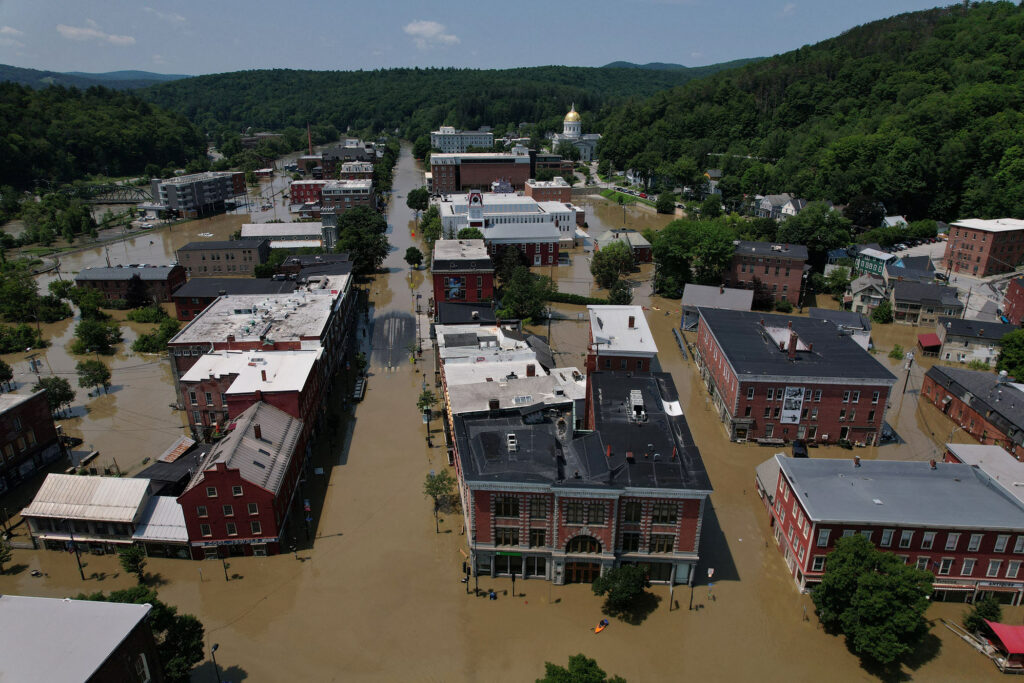
By Cori Fugere Urban, OSV
LUDLOW, Vt. — As flood waters rose throughout Vermont during the July 10 torrential rains, at least one Catholic parish opened its facilities for people who needed a place to wait out the flooding and make post-flood plans.
In Ludlow, Father Thomas Mosher, pastor of Annunciation Parish, opened the parish hall and parking lot to people who needed a place to stay the night of July 10.
About a dozen people slept in the parish hall, where a parishioner furnished a hot meal. Others parked their campers and stayed in the parking lot where still others found a safe place to leave their cars. “We’re on higher ground,” the pastor said.
“Word went out through the community, and people heard they could come,” Father Mosher told Vermont Catholic, Burlington’s diocesan publication. “Really, there was nowhere else to go.”
The community center, designated for just such an emergency center, had been flooded. “It’s one of the corporal works of mercy — shelter the homeless,” the pastor said, adding that people were not necessarily homeless but had to be evacuated from their homes because of the flooding.
He surveyed the “devastation” by car and noted many people were pumping water from their basements. Route 103 had been reopened, but many side roads were still closed and some bridges impassable. One mudslide left the railroad tracks the land had supported hanging like a clothesline. “Usually we have six trains a day passing through,” Father Mosher said.

Many people were asking, “What, again?” he said, referring to the devastation that happened in Vermont during Tropical Storm Irene in 2011.
An updated survey of damage to church property in the statewide Burlington Diocese indicated several churches and rectories had water in the basement. There also were three properties with ceiling damage, and one church with minor exterior damage. The athletic fields of Mount St. Joseph Academy in Rutland were flooded. This information was provided by Peter Beauregard, director of properties for the Diocese of Burlington.
Parts of one of Vermont’s main highways, Interstate 89, were closed in both directions July 10. According to Vermont State Police, the closures were necessary because of excessive water on the roadway and the inability of drainage systems to keep pace with the volume of water. By mid-morning July 11, the highway had reopened.
Vermont State Police was aware of reports that an unknown number of vehicles were stranded in the vicinity of the on-ramps to I-89 northbound and southbound in Montpelier. There were no reports of immediate threats posed by high water, but the vehicles were unable to move due to flooding and road closures in the area. The state police coordinated a response to this situation, determining the level of public assistance needed, and worked to help vehicles travel southbound on the interstate from this location.
President Joe Biden declared a state of emergency in Vermont July 11.
Vermont Emergency Management warned the same day that dangers from flooding were not over and urged people to continue to use caution noting that floodwaters might contain downed power lines, human and livestock waste, hazardous waste, physical objects and debris, and wild or stray animals.
Across the Connecticut River in New Hampshire, southwestern towns of Winchester and Swanzey were hard hit by flood waters that eroded roads and overflowed a dam. Father Alan Tremblay, pastor of Parish of the Holy Spirit which includes the affected towns, said July 11 that no requests for aid had yet been made, “but that doesn’t mean it won’t happen.”
He suggested that the parish would be offering assistance as needs arose when fall-out from the flooding was felt in the future. “People here look out for each other, … and the church always strives to connect with people” in need, he told Vermont Catholic, Burlington’s diocesan publication.

He expects parishioners will be looking for ways to help their neighbors affected by the flooding “as the days unfold,” and the parish — with two churches in Keene and one in Hinsdale — “stands ready to help because of the generosity of parishioners.”
There are two St. Vincent de Paul food pantries in the parish, one in Keene and one in Winchester.
In Vermont, Vermont Catholic Charities Inc. has an emergency assistance fund.
As clean-up operations got underway across the Northeast, the National Weather Service forecast severe thunderstorms — with heavy downpours and high winds — across the region through at least early July 17.
Close to 10 inches of rain fell July 10 in New York’s Hudson Valley, which news reports said is the amount that usually falls throughout the three months of summer.
“It has been a difficult few days, that’s for sure,” Father Raymond Akeriwe told OSV News July 11.
The priest, a member of the Society of African Missions, is pastor of Most Holy Trinity Catholic Chapel in West Point, New York, which serves the area’s Catholic community, including those at U.S. Military Academy West Point.
Father Akeriwe is a chaplain at West Point and is in residence at Most Holy Trinity rectory along with Father Matthew Pawlikowski, retired senior chaplain at West Point Military Academy.
“Luckily enough, we had quite a number of parishioners who had donated a lot of goodies for our cadets and our field masters,” Father Akeriwe said. “Everything (i.e., Sunday hospitality events) was cancelled because of the rain, so all of that was taken to Sacred Heart Parish (in Highland Falls, New York), where a shelter (for flood victims) was being prepared.”
Krista Wojtaszek, Sacred Heart’s parish administrative assistant, told OSV News, “We have the American Red Cross here, which set up disaster relief efforts in our old school building. We have two parishioners who are managing the food pantry and checking in town to see who may need assistance.”
“We’ve had great volunteers. Our thrift shop ladies have found clothes for people. Many people from the town have come together for those affected,” she added.
At least one resident of Highland Falls died in the flash flooding July 10. Later identified as Pamela Nugent, 43, she was trying to escape her flooding home and was swept away.
Father Akeriwe told OSV News that there was quite a bit of flooding at Most Holy Trinity. “We have big erosion right next to the chapel, which they’re looking at now. It’s almost to the foundation,” he added. “The rectory where I live was also flooded. But thank God we were able to take care of the water without outside help.”
The priest added that West Point’s Jewish chapel “had the worst of it. They had very, very bad flooding, so our religious support office for the chaplains was there to help them. We offered them coolers because they had to turn off their freezers, and ice so they could store perishable goods.”
Wojtaszek said there had been no damage to Sacred Heart Church, including its chapel. “We fared amazingly well; so did our school. If we had damage, we wouldn’t have been able to help (as much). We were blessed.”
“There is some concern that several houses will be too damaged and (rendered) completely uninhabitable. There’s a lot of flooding on first floors and in basements. … A lot of cleaning out of mud,” she said. “There are quite a bit more housing issues and housing destruction here, whereas in West Point the damage is more on the roads.”
Several people were staying at the school through the Red Cross, which also put people up in the Holiday Inn in town, Wojtaszek said. Others were staying with friends and family.
The parish was providing necessities such as water, food, utensils, to-go boxes and groceries, she said. “We’re trying the best we can. It’s great to see the community come together. This was very unique. Most of the time, the water runs off; a lot of the towns here sit on hills. But this time, the water was so strong on the hills, we couldn’t keep up with it.”
Cori Fugere Urban is managing editor of Vermont Catholic, the official publication of the Diocese of Burlington. Contributing to this story was Gina Christian, a national reporter for OSV News.
The Dialog provides readers news to your inbox with the Angelus e-newsletter. Sign up here for a free subscription to the Angelus.






